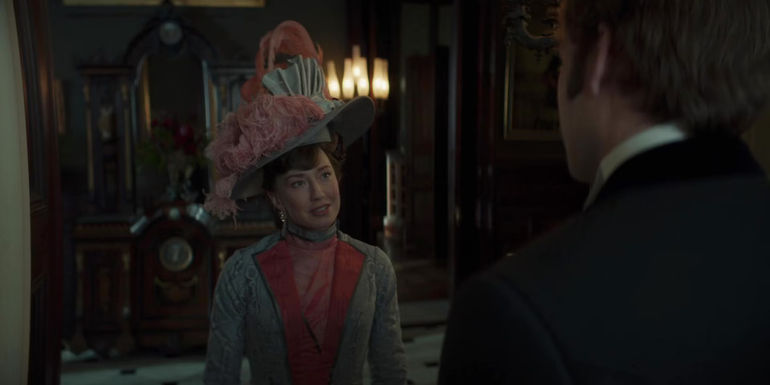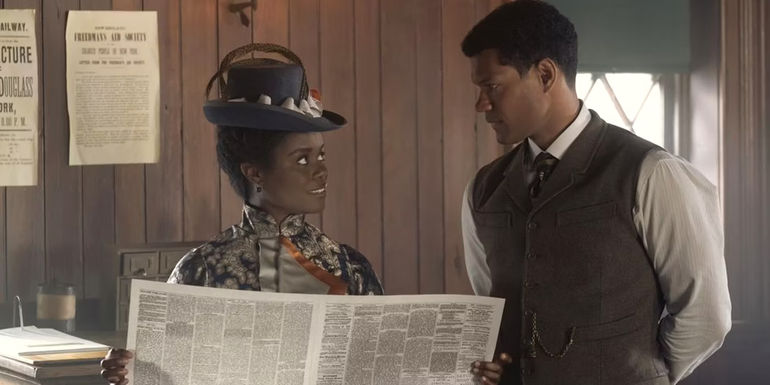
The Gilded Age: A Fictional Adaptation of Historical Events

An in-depth look at how The Gilded Age adapts the history of the 1880s through its characters and storylines.
The Gilded Age and Historical Adaptations
Julian Fellowes' The Gilded Age makes more changes to history than his previous show, Downton Abbey. In the newer series, the lives of Marian Brook (Louisa Jacobson), her aunts Agnes (Christine Baranski) and Ada (Cynthia Nixon), and other fictional characters are interwoven with historical events of the 1880s. Different storylines depict or are inspired by New York's Opera War, the Homestead Strike, and the work of several revolutionary figures.
Carrie Coon as Bertha and Morgan Spector as George in Gilded Age season 2
Several of the characters are loosely based on real-life figures. However, others are stricter adaptations of real people, including the queen of Old New York society, Caroline 'Lina' Astor (Donna Murphy), and Peggy Scott's (Denée Benton) editor at the New York Globe, T. Thomas Fortune (Sullivan Jones). The Gilded Age season 3 will likely continue to create storylines which are similar to history to accurately convey the atmosphere of the titular Gilded Age through the lens of a fictional story.
The Gilded Age season 2 finale The Met Bertha Russell
Historical Figures and Fictional Characters
The Gilded Age season 2 introduces Bertha Russell (Carrie Coon), the ambitious wife of the railroad magnate George Russell (Morgan Spector), as a key player in the Opera War of 1883. This conflict between Old New York and the New Money was a real event, and the show intertwines Bertha's support of the new opera house with historical precedent. However, Bertha's exact actions are fictional, as she was never publicly thanked for her support on opening night. This adaptation blurs the lines between history and fiction, creating a compelling narrative that captures the essence of the Gilded Age.
Bertha Russell holding George Russell's arm in The Gilded Age.
In season 2, episode 4, Peggy accompanies her editor, T. Thomas Fortune (Sullivan Jones), to cover the opening of a new dormitory at the Tuskegee Institute in Alabama, where they meet with Booker T. Washington (Michael Braugher). The show portrays their partnership in the 1880s, although historically, their collaboration occurred a few years later. The Gilded Age takes creative liberties to bring these historical figures into the storyline, adding depth and complexity to their characters.
Carrie Coon as Bertha wearing a red dress on the stairs in The Gilded Age
Oscar van Rhijn (Blake Ritson) spends season 2 hoping to marry Maud Beaton (Nicole Bryndon Bloom), a character inspired by the real-life schemer, Cassie Chadwick. The show intertwines Maud's story with elements of Cassie Chadwick's life, creating a fascinating portrayal of deception and ambition. This adaptation highlights the parallels between fiction and reality, drawing viewers into the captivating world of The Gilded Age.
Bertha speaking to the Duke in The Gilded Age season 2
Reimagined Historical Events
Season 2 of The Gilded Age includes a storyline about George Russell's approach to the Homestead Strike, inspired by the later 1892 strike. The show romanticizes George's efforts to compromise and avert bloodshed, offering a unique perspective on this historical event. By reimagining the Homestead Strike, The Gilded Age creates a compelling narrative that delves into the complexities of labor disputes and societal tensions.
Peggy Scott at the publishing house with Mr Fortune The Gilded Age
The show also explores the involvement of characters like Peggy Scott (Denée Benton) in fighting to keep Black schools open, depicting a partnership between Black and Irish communities to preserve educational opportunities. While the timeline is adjusted for dramatic effect, The Gilded Age sheds light on the challenges and triumphs of marginalized communities in the 1880s, offering a thought-provoking portrayal of historical struggles.
Oscar van Rhijn and Maud Beaton walking together in a park in The Gilded Age.
Additionally, The Gilded Age introduces fictionalized versions of real historical figures, such as the Duke of Buckingham, adding an element of intrigue and drama to the storyline. By blending fact and fiction, the show creates a vivid and immersive portrayal of the Gilded Age, captivating audiences with its rich tapestry of characters and events.
Morgan spector as Geroge Russell in the gilded age season 2





















